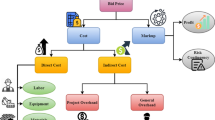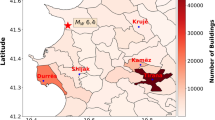Abstract
Within the complex domain of construction project management, the accurate anticipation of time overruns is a significant obstacle, particularly within the specific context of the construction sector in Jordan. This study aimed to utilize deep learning, specifically the Multi-Layer Perceptron (MLP), and enhance its overrun predictive ability by incorporating the Coral Reefs Optimization Algorithm (CROA). The approach employed in our study involved the utilization of a comprehensive dataset encompassing diverse aspects of building projects, ranging from financial indicators to project durations. The Multilayer Perceptron (MLP) was utilized as the underlying framework, and the model's parameters were refined utilizing the Covariance Matrix Adaptation Evolution Strategy (CMA-ES) with Rank-One Adaptation (CROA) to enhance the predictive capabilities. The results of our study indicate that the MLP-CROA continuously showed superior performance compared to the standalone MLP across many metrics. Notably, the MLP-CROA had particularly excellent values in metrics such as R-squared, which suggests its solid predictive capabilities. In conclusion, this study highlights the significant potential for transformation in the Jordanian construction industry by integrating deep learning and bio-inspired optimization methodologies. This process improves forecast accuracy and facilitates proactive project management, potentially directing projects toward timely and cost-effective completion.










Similar content being viewed by others
References
Akinosho, T. D., Oyedele, L. O., Bilal, M., Ajayi, A. O., Delgado, M. D., Akinade, O. O., & Ahmed, A. A. (2020). Deep learning in the construction industry: A review of present status and future innovations. Journal of Building Engineering, 32, 101827.
Ali, K., Amir, E., & Mahdi, M. (2023). Buckling resistance prediction of high-strength steel columns using metaheuristic-trained artificial neural networks. Structures, 56(C), 104853.
Arabiat, A., Al-Bdour, H., & Bisharah, M. (2023). Predicting the construction projects time and cost overruns using K-nearest neighbor and Artificial Neural Network: A case study from Jordan. Asian Journal of Civil Engineering, 24(7), 2405–2414. https://doi.org/10.1007/s42107-023-00649-7
Ashtari, M. A., Ansari, R., Hassannayebi, E., & Jeong, J. (2022). Cost Overrun Risk assessment and prediction in construction projects: A Bayesian network classifier approach. Buildings, 12(10), 1660.
Bin Seddeeq, A., Assaf, S., Abdallah, A., & Hassanain, M. A. (2019). Time and cost overrun in the Saudi Arabian oil and gas construction industry. Buildings, 9(2), 41.
Eltoukhy, M., & Nassar, A. (2021). Using support vector machine (SVM) for time and cost overrun analysis in construction projects in Egypt. International Journal of Civil Engineering and Technology (IJCIET). https://doi.org/10.34218/ijciet.12.3.2021.002
Gharaibeh, L. G., Matarneh, S. T., Arafeh, M., & Sweis, G. (2020). Factors leading to design changes in Jordanian Construction Projects. International Journal of Productivity and Performance Management, 70(4), 893–915. https://doi.org/10.1108/ijppm-08-2019-0412
Ghazali, F., & Wong, H. (2014). Risk ranking for tunnelling construction projects in malaysia. Journal of Construction Engineering and Project Management, 4(1), 29–36. https://doi.org/10.6106/jcepm.2014.4.1.029
Gómez-Cabrera, A., Gutierrez-Bucheli, L., & Muñoz, S. (2023). Causes of time and cost overruns in construction projects: A scoping review. International Journal of Construction Management. https://doi.org/10.1080/15623599.2023.2252288
Gómez-Cabrera, A., Salazar, L. A., Ponz-Tienda, J. L., & Alarcón, L. F. (2020). Lean tools proposal to mitigate delays and cost overruns in construction projects. In Proceedings of the 28th annual conference of the international group for lean construction (IGLC). https://doi.org/10.24928/2020/0049.
Gondia, A., Siam, A., El-Dakhakhni, W., & Nassar, A. H. (2020). Machine learning algorithms for construction projects delay risk prediction. Journal of Construction Engineering and Management, 146(1), 04019085.
Hu, Z., Karami, H., Rezaei, A., Dadras Ajirlou, Y., Piran, M. J., Band, S. S., & Mosavi, A. (2021). Using soft computing and machine learning algorithms to predict the discharge coefficient of curved labyrinth overflows. Engineering Applications of Computational Fluid Mechanics, 15(1), 1002–1015.
Kamaruddeen, A. M., Sung, C. F., & Wahi, W. (2020). A study on factors causing cost overrun of construction projects in Sarawak, Malaysia. Civil Engineering and Architecture, 8(3), 191–199. https://doi.org/10.13189/cea.2020.080301
Kaveh, A. (2014). Advances in metaheuristic algorithms for optimal design of structures (pp. 9–40). Springer.
Kaveh, A., Dadras, E. A., Javadi, S. M., & Geran, M. N. (2021). Machine learning regression approaches for predicting the ultimate buckling load of variable-stiffness composite cylinders. Acta Mechanica, 232, 921–931.
Kaveh, A., Eskandari, A., & Movasat, M. (2023). Buckling resistance prediction of high-strength steel columns using metaheuristic-trained artificial neural networks. Structures, 56(C), 104853.
Kaveh, A., Gholipour, Y., & Rahami, H. (2008). Optimal design of transmission towers using genetic algorithm and neural networks. International Journal of Space Structures, 23(1), 1–19.
Kaveh, A., & Khavaninzadeh, N. (2023, June). Efficient training of two ANNs using four meta-heuristic algorithms for predicting the FRP strength. In Structures (Vol. 52, pp. 256–272). Elsevier.
Maltbie, N., Niu, N., Van Doren, M., & Johnson, R. (2021, August). XAI tools in the public sector: A case study on predicting combined sewer overflows. In Proceedings of the 29th ACM joint meeting on European software engineering conference and symposium on the foundations of software engineering (pp. 1032–1044).
Mishra, A., Bhandari, S., & Jha, T. (2018). Factors affecting performance and time extension of ongoing construction projects under town development fund, Nepal. Journal of Advanced Research in Construction & Urban Architecture, 03(04), 7–25. https://doi.org/10.24321/2456.9925.201805
Moghayedi, A., & Windapo, A. (2020, December). Predicting the impact size of uncertainty events on construction cost and time of highway projects using ANFIS technique. In Collaboration and integration in construction, engineering, management and technology: Proceedings of the 11th international conference on construction in the 21st century, London 2019 (pp. 203–209). Springer.
Moon, H., Williams, T. P., Lee, H. S., & Park, M. (2020). Predicting project cost overrun levels in bidding stage using ensemble learning. Journal of Asian Architecture and Building Engineering, 19(6), 586–599.
Natarajan, A. (2022). Reference class forecasting and machine learning for improved offshore oil and gas megaproject planning: Methods and application. Project Management Journal, 53(5), 456–484.
Rofooei, F. R., Kaveh, A., & Masteri, F. F. (2011). Estimating the vulnerability of concrete moment resisting frame structures using artificial neural networks. International Journal of Operational Research, 1(3), 433–448.
Sambasivan, M., & Soon, Y. (2007). Causes and effects of delays in Malaysian construction industry. International Journal of Project Management, 25(5), 517–526. https://doi.org/10.1016/j.ijproman.2006.11.007
Sanni-Anibire, M. O., Zin, R. M., & Olatunji, S. O. (2021). Developing a machine learning model to predict the construction duration of tall building projects. Journal of Construction Engineering, 4(1), 022–036.
Sharma, S., & Gupta, A. K. (2021). Analysis of factors affecting cost and time overruns in construction projects. Lecture Notes in Civil Engineering. https://doi.org/10.1007/978-981-33-6969-6_6
Shoar, S., Chileshe, N., & Edwards, J. D. (2022). Machine learning-aided engineering services’ cost overruns prediction in high-rise residential building projects: Application of random forest regression. Journal of Building Engineering, 50, 104102.
Siyabi, H., & Khaleel, O. (2021). Cost overrun in construction projects in Oman: Case study. Journal of Student Research. https://doi.org/10.47611/jsr.v10i3.1382
Sohrabi, H., & Noorzai, E. (2022). Risk-supported case-based reasoning approach for cost overrun estimation of water-related projects using machine learning. Engineering, Construction and Architectural Management., 2022, 1.
Uddin, S., Ong, S., & Lu, H. (2022). Machine learning in project analytics: A data-driven framework and case study. Scientific Reports, 12(1), 15252.
Yin, Z., Zahedi, L., Leon, A. S., Amini, M. H., & Bian, L. (2022). A machine learning framework for overflow prediction in combined sewer systems. In World environmental and water resources congress 2022 (pp. 194–205).
Funding
The authors received no funding from any entity for the work they submitted.
Author information
Authors and Affiliations
Contributions
all authors wrote, analyze , prepared figures and reviewed the manuscript .
Corresponding author
Ethics declarations
Competing interests
The authors declare no competing interests.
Conflict of interest
The authors declare that they have no conflict of interest.
Additional information
Publisher's Note
Springer Nature remains neutral with regard to jurisdictional claims in published maps and institutional affiliations.
Rights and permissions
Springer Nature or its licensor (e.g. a society or other partner) holds exclusive rights to this article under a publishing agreement with the author(s) or other rightsholder(s); author self-archiving of the accepted manuscript version of this article is solely governed by the terms of such publishing agreement and applicable law.
About this article
Cite this article
Shihadeh, J., Al-Shaibie, G., Bisharah, M. et al. Evaluation and prediction of time overruns in Jordanian construction projects using coral reefs optimization and deep learning methods. Asian J Civ Eng 25, 2665–2677 (2024). https://doi.org/10.1007/s42107-023-00936-3
Received:
Accepted:
Published:
Issue Date:
DOI: https://doi.org/10.1007/s42107-023-00936-3




